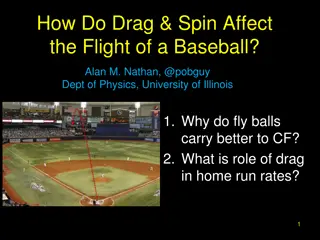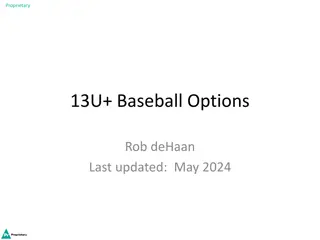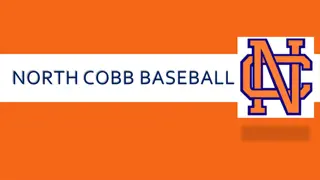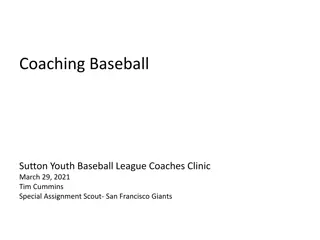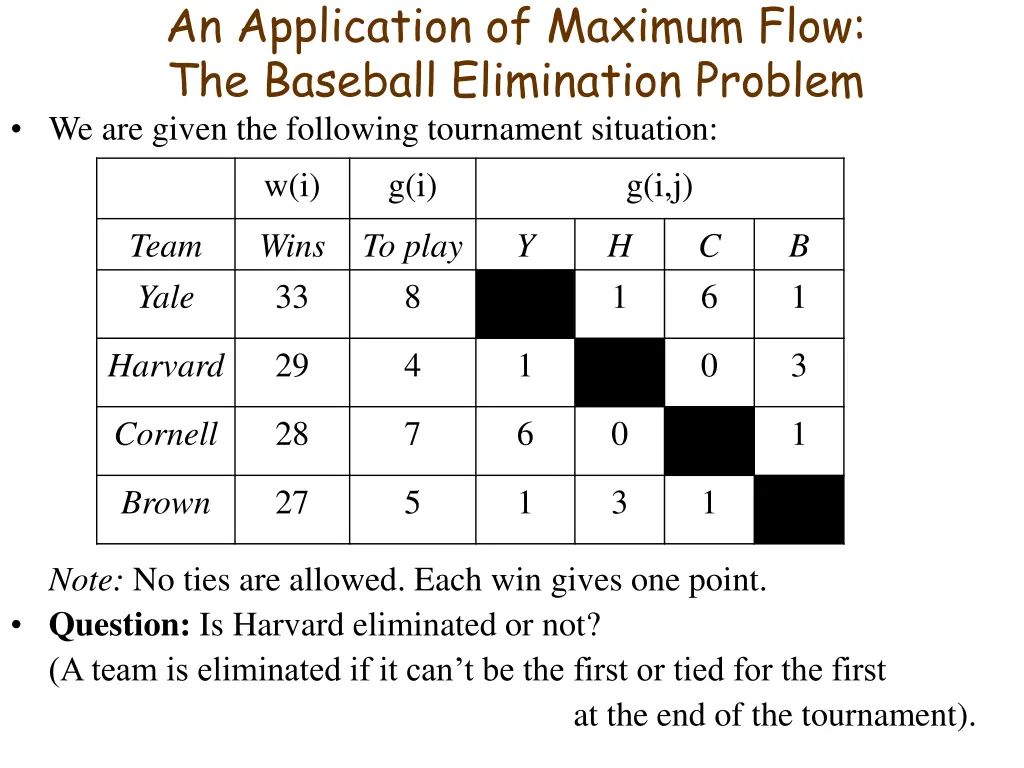
Solving Baseball Elimination Problem via Maximum Flow
"Learn how to solve the baseball elimination problem using maximum flow theory. Determine if Harvard is eliminated based on game outcomes and maximum flow analysis. Discover the optimal flow values and minimum-cut arguments for Harvard's elimination."
Download Presentation

Please find below an Image/Link to download the presentation.
The content on the website is provided AS IS for your information and personal use only. It may not be sold, licensed, or shared on other websites without obtaining consent from the author. If you encounter any issues during the download, it is possible that the publisher has removed the file from their server.
You are allowed to download the files provided on this website for personal or commercial use, subject to the condition that they are used lawfully. All files are the property of their respective owners.
The content on the website is provided AS IS for your information and personal use only. It may not be sold, licensed, or shared on other websites without obtaining consent from the author.
E N D
Presentation Transcript
An Application of Maximum Flow: The Baseball Elimination Problem We are given the following tournament situation: w(i) g(i) g(i,j) Team Yale Wins 33 To play 8 Y H 1 C 6 B 1 29 4 1 0 3 Harvard 28 7 6 0 1 Cornell 27 5 1 3 1 Brown Note: No ties are allowed. Each win gives one point. Question: Is Harvard eliminated or not? (A team is eliminated if it can t be the first or tied for the first at the end of the tournament).
The Baseball Elimination Problem: Preliminary Analysis The maximum number of points Harvard can get is W = 29 + 4 = 33 Suppose Harvard wins all its remaining games. It will not be eliminated if and only if Brown has no more than u(B) = W-w(B) = 33-27 = 6 wins in the remaining games; Cornell has no more than u(C) = W-w(C) = 33-28 = 5 wins in the remaining games; Yale has no more than u(Y) = W-w(Y) = 33-33 = 0 wins in the remaining games. Let Pbe the set of all the teams other than Harvard: P = {Y, C, B} Let Q be the set of all possible pairs of P-teams: Q = { (Y,C), (Y,B), (C,B) } The total number of games to be played between P-teams is G = 6+1+1 = 8 . (by winning all its games)
Solving the Baseball Elimination Problem via Maximum Flow The baseball elimination problem can be solved by creating and solving a related instance of maximum flow problem: Create a source node O (all the games originate here). Create a node for each pair from Q; for each Q-node (i, j), add an arc from O to (i, j); the arc s capacity is the number of games to be played between i and j. Create a node for each team from P; for each Q-node (i, j), add arcs from (i ,j) to P-nodes i and j; cap( (i,j) i ) = cap( (i,j) j ) = cap( O (i,j) ) . Create sink node T (the wins of the teams are recorded here). Add an arc from any P-node j to T; the capacity of the arc is u(j) . 6 Y,C Y 0 6 6 1 5 1 T C Y,B O 1 1 1 6 1 C,B B
Solving the Baseball Elimination Problem via Maximum Flow Find the maximum flow from O to T in the resulting network. If maximum flow value = G (total number of remaining games among P-teams) then Harvard still has chances to be number one, else Harvard is eliminated. (that is, if all the games can be played so that teams Y, C, B get no more than u(Y), u(C), u(B) wins correspondingly, then Harvard still can be number one). For our example, the bold red numbers on the arcs show the optimal flow values. Since the maximum flow value is 7 < 8 = G, Harvard is eliminated. 6 Y 0 Y,C 6 5 5 6 1 5 5 1 1 T C Y,B O 1 1 2 1 1 1 6 1 1 C,B B
Showing the elimination of Harvard using minimum-cut-based arguments The O-side of the minimum cut is {O, (Y,C), Y, C} (the set of the nodes that are reachable from O via augmenting paths) The team nodes on the O-side are Y and C. The number of games to be played between Y and C is 6. But the maximum number of total wins for Y and C, that allows Harvard to be number one, is 0+5 = 5. Thus, Harvard is eliminated. 6 Y,C 5 Y 0 Min cut 6 5 6 1 5 5 1 1 T C Y,B O 1 1 2 1 1 1 6 1 1 C,B B
Showing the elimination of Harvard using minimum-cut-based arguments Below is a different way to show the elimination of Harvard. The team nodes on the O-side are Y and C. The total number of wins between Y and C is (33 + 28) + 6 = 67. Then the average number of wins is 67 / 2 = 33.5 . This means that one of Y and C will certainly get 34points. So Harvard is eliminated with its maximum possible 33 points. Generally, suppose we have teams 0, 1, , n. If there is a set of teams R {1, ,n} such that i + w(i) g(R) R W | R | (g(R) = total number of games to be played among R) then team 0 is eliminated. Claim: If team 0 is eliminated, then R = team nodes on the O-side of the minimum cut.






